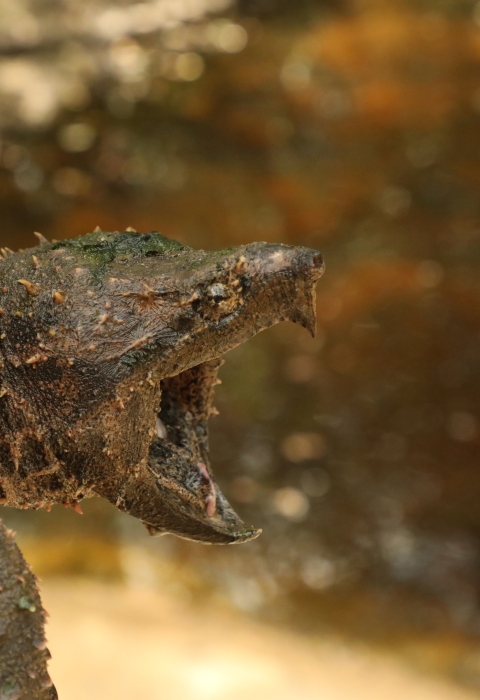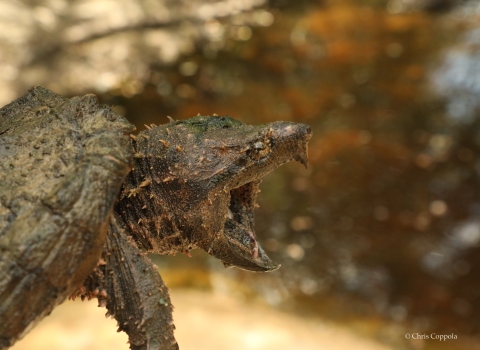What action is the U.S. Fish and Wildlife Service taking?
The Service is proposing to list the Suwannee alligator snapping turtle as threatened under the Endangered Species Act (ESA). As part of the proposed rule, the Service is also proposing a 4(d) rule. The Service determined that designating critical habitat for the species is not prudent since the designation could increase the degree of threat from poaching.
What is the Suwannee alligator snapping turtle?
Alligator snapping turtles are the largest freshwater turtles in North America with adult males weighing more than 200 pounds. Like all snapping turtles, they have rough brown shells and very long tails, nearly as long as the body. They are also characterized by three sharp ridges or keels that run the length of the carapace (upper shell), exceptionally large heads that appear triangular from above, strongly hooked beaks and extra rows of scales near the edge of the carapace.
Recently, the alligator snapping turtle (Macrochelys) was split into two distinct species: alligator snapping turtles (Macrochelys temminckii) and Suwannee alligator snapping turtles (Macrochelys suwanniensis). This proposed listing applies only to the Suwannee alligator snapping turtle species.
Where does this turtle live?
These turtles are only found in the Suwannee River Basin in Northern Florida and Southern Georgia.
How many of these turtles are there?
It is estimated that there are about 2,000 of these turtles across their entire range in Georgia and Florida.
Why is the Service proposing a threatened listing for the Suwannee alligator snapping turtle?
The ESA describes two categories of species that need protection: threatened and endangered. An endangered animal or plant is one that is in danger of extinction throughout all or a significant portion of its range; a threatened animal or plant is one that is likely to become endangered in the foreseeable future.
After careful examination of the turtle’s past, present and projected future conditions, the Service has determined it meets the definition of a threatened species under the ESA. The turtle is not being listed as endangered because its current condition still provides sufficient resiliency, redundancy and representation such that it is not currently at risk of extinction.
How did the Service arrive at this finding?
The Service conducted a thorough review of the Suwannee alligator snapping turtle via a Species Status Assessment (SSA). The SSA, produced with input from many partners, underwent independent peer and partner review. It provides a biological risk assessment using the best available scientific and commercial information on threats to a species and evaluates a species’ current condition. The SSA also forecasts a species’ future status under varying scenarios and forms the foundational basis for a species’ recovery plan, should it become listed.
The SSA conducted for the Suwannee alligator snapping turtle showed its populations are in decline and expected to continue to decline into the foreseeable future. The final SSA report for the turtle is available on the Service Catalog and the Federal eRulemaking Portal. In the Search box, enter FWS–R4–ES–2021–0007, which is the docket number for this rulemaking.
What threats were identified for the turtle?
Factors affecting the future viability of the Suwannee alligator snapping turtle include illegal harvest, by-catch from recreational and commercial fishing, hook ingestion, habitat alteration, and nest predation. Historically, extensive commercial and recreational take in the 20th century resulted in significant declines to many alligator snapping turtle populations. Commercial harvesting negatively impacted populations in Florida and Georgia.
Recreational harvest of Suwannee alligator snapping turtles is currently prohibited in both states. Florida prohibited the commercial harvest of all alligator snapping turtles in 1972 and recreational harvest in 2009; Georgia prohibited all harvest in 1992. Although these restrictions have decreased the number of alligator snapping turtles being harvested, populations have not necessarily increased in response. This is likely due to the turtle’s relatively low reproductive output and long generation times.
How will ESA protections benefit these turtles?
Listing under the ESA provides immediate protection, promotes recovery, and generates greater public awareness about the threats and conservation opportunities. It also inspires actions by diverse partners, including federal, state, tribal and local agencies; industry; conservation groups; and individuals.
Targeted protections: Under the ESA, federal agencies must ensure actions they approve, fund or carry out do not jeopardize the continued existence of a listed species or destroy its critical habitat. In addition, the ESA protects listed species and their habitats by prohibiting “take” and interstate or international trade in listed species (including their parts and products), except under federal permit.
Take is defined by the ESA as, “to harass, harm, pursue, hunt, shoot, wound, kill, trap, capture, or collect or attempt to engage in any such conduct.” Harm is defined as, “an act which actually kills or injures wildlife.” Such an act may include significant habitat modification or modification or degradation that actually kills or injures wildlife by significantly impairing essential behavioral patterns, including breeding, feeding or sheltering.
Recovery efforts: The ESA also requires the Service to develop and implement recovery plans for the conservation of threatened and endangered species. Recovery plans outline actions that are needed to improve the species’ status, so they no longer require protection under the ESA. The Service develops and implements these plans in partnership with species experts; federal, state and local agencies; tribes; non-governmental organizations; academia; and other stakeholders.
Is the Service designating critical habitat for the turtle?
The Service determined that designating critical habitat for the species is not prudent since the designation could increase the degree of threat from poaching. Designating critical habitat would entail identifying locations where large turtles could be found, potentially increasing the threat of illegal harvest on the species.
What is the 4(d) rule that is being proposed for the species?
For threatened species, the Service may use the flexibility provided under the ESA’s Section 4(d) to tailor take prohibitions to those that provide conservation benefits for the species – referred to as a 4(d) rule. The proposed 4(d) rule would promote conservation of the Suwannee alligator snapping turtle by discouraging illegal harvest by prohibiting take and implementing use of best management practices for activities in freshwater wetlands and riparian riparian
Definition of riparian habitat or riparian areas.
Learn more about riparian areas to minimize habitat alteration.
The provisions of this proposed rule are some of the many tools the Service would use to promote the conservation of Suwannee alligator snapping turtle.
The proposed 4(d) rule would prohibit take; import and export; possession, delivery, and shipping; interstate and foreign commerce; and sale or offer for sale. The Service is also proposing several exceptions to the prohibitions.
Those excepted actions are: take incidental to any otherwise lawful activity caused by Federal and State captive breeding programs to support conservation efforts for wild populations with permitted, brood stock; construction, operation, and maintenance activities; pesticide and herbicide use; silviculture practices and forestry activities that implement industry and/or State-approved best management practices accordingly; and maintenance dredging that affects previously disturbed portions of the maintained channel.
This proposed 4(d) rule would apply only if and when the Service finalizes the listing of Suwannee alligator snapping turtle as a threatened species.
What conservation efforts are currently being undertaken for the turtle?
Levels of protection and conservation measures vary from state to state. Regulatory programs for Suwannee alligator snapping turtle may include: regulations that prohibit possession, purchase, sale, transport, or export; and inclusion on Florida and Georgia State lists of threatened wildlife.
In addition, the Suwannee River Water Management District (SRWMD) manages the water and other related resources within the range of the Suwannee alligator snapping turtle including the Suwannee, Withlacoochee, Alapaha, Santa Fe, and Ichetucknee rivers within Florida. The agency monitors the water quantity and quality by regular testing and reporting. Water-use restrictions are implemented by SRWMD in order to conserve freshwater resources of springs and rivers within the SRWMD. These restrictions contribute to maintaining healthy groundwater levels and flows.
How will commercial and recreational fishermen be affected?
The Service’s 4(d) portion of the proposed rule would prohibit all forms of intentional take, including those resulting from interstate and international trade. The rule also addresses prohibitions and exemptions for incidental take from otherwise lawful activities, focusing on implementing existing best management practices for instream work and impacts to riparian areas.
An important aspect of the draft 4(d) rule solicits public comment on developing turtle exclusion or escape devices for hoop nets and modified techniques for trotlines to address bycatch from those commercial and recreational fishing gears. We are also considering adding a provision requiring the reporting of all injured or dead Suwannee alligator snapping turtles resulting from bycatch from recreational or commercial fishing to the Service within 72 hours.
This reporting requirement is consistent with state regulations and will help us better understand threats associated with lawful fishing bycatch.
How can the public comment on this proposal?
The Service will accept comments received or postmarked on or before June 7, 2021. Comments submitted electronically using the Federal eRulemaking Portal (see ADDRESSES, below) must be received by 11:59 p.m. Eastern Time on the closing date. We must receive requests for public hearings, in writing, at the address shown in FOR FURTHER INFORMATION CONTACT below by May 24, 2021.
Addresses
You may submit comments by one of the following methods:
Electronically: Go to the Federal eRulemaking Portal. In the Search box, enter FWS–R4–ES–2021–0007, which is the docket number for this rulemaking. Then, click on the Search button. On the resulting page, in the Search panel on the left side of the screen, under the Document Type heading, check the Proposed Rule box to locate this document. You may submit a comment by clicking on “Comment Now!”.
By hard copy: Submit by U.S. mail: Public Comments Processing, Attn: FWS–R4–ES–2021–0007, U.S. Fish and Wildlife Service, MS: PRB/3W, 5275 Leesburg Pike, Falls Church, VA 22041–3803.
We request that you send comments only by the methods described above. We will post all comments on regulations.gov. This generally means that we will post any personal information you provide us.
Contact
- Jay Herrington, Field Supervisor, Northeast Florida Ecological Services Field Office; Jay_Herrington@fws.gov, 904–731–3191 or Panama City Ecological Services Field Office, 1601 Balboa Avenue, Panama City, FL 32405.
- Persons who use a telecommunications device for the deaf (TDD) may call the Federal Relay Service at 800–877–8339.




